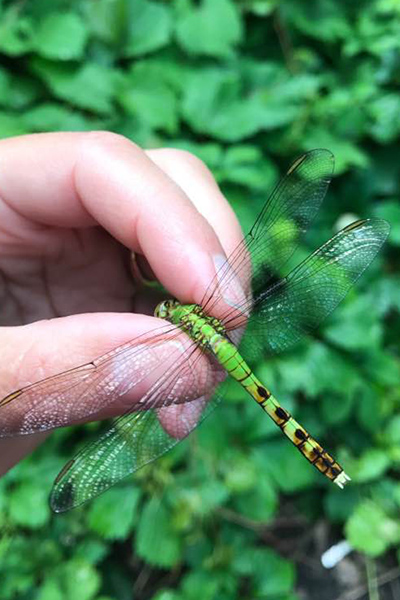
Did you know that tallgrass prairie is one of the most endangered ecosystems in the world with less than one percent of virgin, untilled prairie left? Or that we have some of the best remaining swathes of prairie right here in Pope County, MN? On the rolling hills at Glacial Lakes State Park, nearly 150 people from all over the state gathered on Saturday, starting as early as 5 A.M. and staying until long past dark, to learn more about tallgrass prairie and its management.
Tallgrass prairie needs disturbance to thrive. Many of us have seen the controlled burns used as part of prairie management, but fewer know that prairie also needs animal impact to maintain its health and diversity. In the past buffalo provided that disturbance, travelling through in herds and trampling growth into the soil. Now we need to use livestock to mimic this… and the BioBlitz aimed to show how effective that can be.
The 2017 BioBlitz focused on public lands in partnership with the US Fish and Wildlife Service (USFWS) and MN Department of Natural Resources (MN DNR), featuring land managed by the DNR, USFWS agents and local farmers. Glacial Lakes State Park was in the center of the focus area and shuttles were provided to the survey sites. This was the third Tallgrass Prairie BioBlitz organized by Land Stewardship Project, The Chippewa River Watershed Project and CURE in the past four years.
We began with an early morning bird survey and then transitioned into five 90-minute surveys throughout the day. DNR staff, US Fish and Wildlife staff, MN Master Naturalists and local prairie enthusiasts joined to lead surveys that catalogued MN birds, upland and wetland prairie plants, MN dragonflies, prairie insects, MN amphibians and reptiles, wetland macro-invertebrates, and bats.

We surveyed land within Glacial Lakes State Park, but also surrounding land: A Waterfowl Production Area owned and managed by the US Fish and Wildlife service, and lands owned by park neighbor and grazier Jim Wulf, managed with rotational grazing for native species diversity and health. The species diversity was high, spotting grasshopper sparrows and dickcissels, cataloguing 3 new dragonfly species in the county, and spotting hundreds of prairie plants. Clearly the livestock impact as part of the management plan is helping these parcels to thrive. Jim spoke at lunch and described how careful rotation of pastures and long rest periods has increased plant diversity, wildlife, and forage quality and quantity on his own farm as well.

In addition to surveys, the day included several presentations on subjects like growing prairie plants at home, MN dragonflies, local geology, soil biology, “The Secret Lives of Earthworms”, and more. With children’s programming with the DNR, prairie walks, and presentations there was something for everyone all day long. People could arrive for part or the entire event and could follow their interests in picking a survey they wanted to learn more about, or hang back at the event headquarters and attend one of the presentations that were scheduled throughout the day. Lunch and a potluck supper featured local meats from Early Boots Farm, Pastures a Plenty, and Kadejan.
Why do we do the BioBlitz? It’s an amazing opportunity for community members to pair up with local experts to learn about and identify native species, but it’s also a chance to share excitement, knowledge, and to strengthen our ties to each other and the prairie around us.

“Connecting people, especially children, to the outdoors and teaching them about the wonders of the tallgrass prairie is extremely important. The tallgrass prairie is the most threatened ecosystem in the United States. People only protect places that they have deep rooted connections to. Events such as a BioBlitz provide opportunities to learn about the natural world around us and make multi-generational memories.” – Peg Furshong, Director of Programs at CURE
This event was open to the public and was made possible with financial support from the National Fish and Wildlife Foundation and the Lac qui Parle Lake Watershed Project Association. It was sponsored by Land Stewardship Project, The Chippewa River Watershed Project, and CURE. It would not have been possible without all of the support we received from the area farmers, US Fish and Wildlife Service, Minnesota DNR, Minnesota Dragonfly Society and many other volunteers that shared not only their knowledge but also their passion for the tallgrass Prairie. We want to thank everyone who came out and joined us!
Story by Peg Furshong (CURE) & Robin Moore (LSP)


